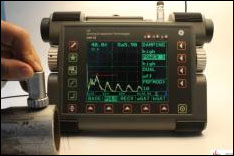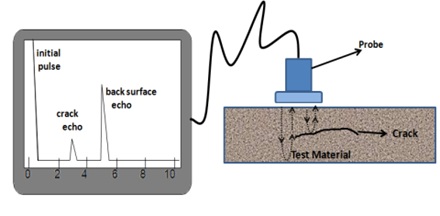 |
Ultrasonic Flaw Detection
Ultrasonic Testing is a pulsed beams of ultrasound are used and in the simplest instruments a single probe is hand-held, is placed on the specimen surface. ultrasonic testing (UT), very short ultrasonic pulse-waves with center frequencies ranging from 0.1-15 MHz and occasionally up to 50 MHz are launched into materials to detect internal flaws or to characterize materials. An oscilloscope display with a time-base shows the time that it takes for an ultrasonic pulse to travel to a reflector (a flaw, the back surface, or other free surface) in terms of distance across the oscilloscope screen is called A-scan display. The height of the reflected pulse is related to the flaw size as seen from the transmitter probe. The relationships of flaw size, flaw distance and flaw reflectivity are complex and considerable skill is required to interpret the display. By suitable design of probe, ultrasonic beams can be introduced into solid material at almost any angle. Advantages
|
||
|


 High penetrating power, which allows the detection of flaws deep in the part.
High penetrating power, which allows the detection of flaws deep in the part.